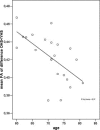White matter tract integrity in aging and Alzheimer's disease
- PMID: 18412132
- PMCID: PMC6870688
- DOI: 10.1002/hbm.20563
White matter tract integrity in aging and Alzheimer's disease
Abstract
The pattern of degenerative changes in the brain white matter (WM) in aging, mild cognitive impairment (MCI), and Alzheimer's disease (AD) has been under debate. Methods of image analysis are an important factor affecting the outcomes of various studies. Here we used diffusion tensor imaging (DTI) to obtain fractional anisotropy (FA) measures of the WM in healthy young (n = 8), healthy elderly (n = 22), MCI (n = 8), and AD patients (n = 16). We then applied "tract-based spatial statistics" (TBSS) to study the effects of aging, MCI, and AD on WM integrity. Our results show that changes in WM integrity (that is, decreases in FA) are different between healthy aging and AD: in healthy older subjects compared with healthy young subjects decreased FA was primarily observed in frontal, parietal, and subcortical areas whereas in AD, compared with healthy older subjects, decreased FA was only observed in the left anterior temporal lobe. This different pattern of decreased anatomical connectivity in normal aging and AD suggests that AD is not merely accelerated aging.
2008 Wiley-Liss, Inc.
Figures



References
-
- Ashburner J,Friston KJ ( 2000): Voxel‐based morphometry—The methods. Neuroimage 11: 805–821. - PubMed
-
- Behrens TE,Johansen‐Berg H,Woolrich MW,Smith SM,Wheeler‐Kingshott CA,Boulby PA,Barker GJ,Sillery EL,Sheehan K,Ciccarelli O,Thompson AJ,Brady JM,Matthews PM ( 2003): Non‐invasive mapping of connections between human thalamus and cortex using diffusion imaging. Nat Neurosci 6: 750–757. - PubMed
-
- Bookstein FL ( 2001): Voxel‐based morphometry should not be used with imperfectly registered images. Neuroimage 14: 1454–1462. - PubMed
Publication types
MeSH terms
LinkOut - more resources
Full Text Sources
Medical

